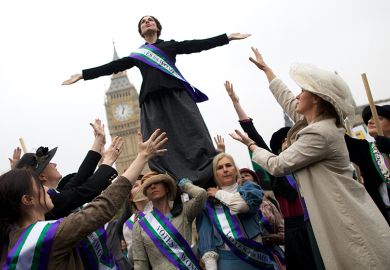The main focus of this book is the three most famous women bookbinders of the period: Sarah Prideaux, Katherine Adams and Sybil Pye. Their work is sufficient in itself to warrant a look at the conditions in which women in general learned the trade. For they occasionally show weaknesses in technique, which raises questions about how difficult it was to learn their craft.
Marianne Tidcombe draws together the evidence of how women suffered from lack of training. Only boys could train as apprentices. Women in trade binderies were excluded from high-status work: they were given the folding and sewing jobs rather than what was considered the skilled work.
Those women who could afford it had a few months' training within a professional bindery, some with the famous male binders of the period: T.J. Cobden-Sanderson, Douglas Cockerell and Joseph Zaehnsdorf. What the women learned, they passed on, teaching each other. However, such training was rarely enough.
According to Tidcombe, the best Prideaux bindings were executed by the Frenchman Lucien Broca, and Pye's technique "sometimes show(ed) certain weaknesses that are consistent with her having learned the techniques in isolation". Only Adams, Prideaux's pupil and friend, is free from such criticism.
Tidcombe employs three approaches to her subject. A historical review traces women's binding activity from the earliest documented binder, in Edward II's reign, to the trade unionism of the early 20th century. This is followed by chapters on the materials and techniques used by women binders, including sections on embroidered cloth, painted vellum, modelled leather and poker-work bindings. Finally, she narrates the individual histories of her subjects: Prideaux, Adams, Pye and their pupils in Britain and abroad; Frank Karslake and the members of the Guild of Women Binders; and the other women pupils of Cobden-Sanderson, Cockerell, and Zaehnsdorf.
Aimed primarily at book collectors, bibliophiles and auctioneers, this is a pleasantly bound book with 46 colour plates and 141 figures. It also contains useful appendices, including illustrations of the tools and listings of the bindings of the main female binders.
Nevertheless, a couple of chapters in the book have wider appeal for those interested in the position of women in the book trade. Tidcombe's chapter on women in trade binderies vividly illustrates how job demarcation worked to prevent women gaining necessary experience.
And there are some pleasant historical touches in the introductory chapter, too. Tidcombe shows how the mending and covering of books were part of a woman's job in taking care of the house. For instance, Robert Southey's daughters covered between 1,200 and 1,400 of his books in printed cotton fabrics, calling on the aid of unsuspecting female visitors to help them.
The book is described as "a short general survey giving a brief account of the lives and work of women" who started binding before 1914. Its variety of approach makes it highly readable. And underpinning it is some useful reference material that points to other avenues of research, such as, how did the women listed "in charge of bookbinder shops from 1648 to 1901" successfully run their businesses?
Alexis Weedon is senior lecturer in media arts, University of Luton.
Women Bookbinders 1880-1920
Author - Marianne Tidcombe
ISBN - 0 7123 0411 8
Publisher - British Library
Price - £35.00
Pages - 240
Register to continue
Why register?
- Registration is free and only takes a moment
- Once registered, you can read 3 articles a month
- Sign up for our newsletter
Subscribe
Or subscribe for unlimited access to:
- Unlimited access to news, views, insights & reviews
- Digital editions
- Digital access to THE’s university and college rankings analysis
Already registered or a current subscriber?



